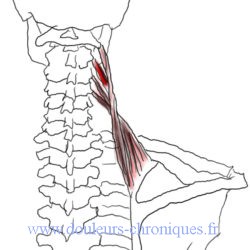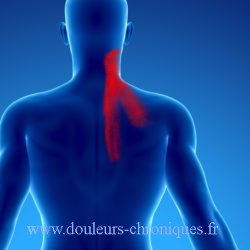Anatomical reminder

The levator scapula attaches above to the transverse processes of the first 4 cervical vertebrae and below to the superomedial angle of the scapula.
Its role is:
- to elevate the medial aspect of the scapula upwards and allow downward rotation of the glenoid at the glenohumeral joint.
- allow extension and anterior ipsilateral rotation of the neck
Myofascial syndrome of the levator scapula
Description
Referred pain from this muscle is intense and causes cervical discomfort with intense rotation and flexion: this is the torticollis muscle

This pain is localized mainly at the angle of the neck, an irradiation is possible on the medial edge of the scapula as well as towards the posterior part of the shoulder joint.
Triggers and maintenance factors
- Type on the computer with a screen on the side for a long time.
- Talking on the phone with the head rotated see in lateral flexion
- Sleeping with the head tilted to the side (in a car seat, airplane seat, etc.)
- Prolonged shoulder elevation (seat armrests too high, use of a cane that is too long)
- Unusual muscle overuse (frequent head rotation such as swimming front crawl, watching a game of ball game)
Diagnostic
The patient is in a frozen attitude, he looks around him turning his eyes and the trunk but not the neck. The head is tilted slightly towards the painful side.
The rotation of the neck is very limited towards the affected side, on the other hand flexion and extension of the neck are possible.
Palpation of the painful area located at the corner of the neck is done by pushing the trapezius at this level, backwards. This palpation reproduces part of the pain.
Another painful area is common and is between 1 and 2 cm above the shoulder blade.
Treatment
Stretching the muscle by applying forward and lateral flexion on the side opposite the pain.
Treatment is sometimes difficult because myofascial syndrome of the levator scapulae is often associated with damage to the splenius, scalenes, and other posterior muscles of the neck.
Sometimes infiltration of the muscle in the painful area with 1% lidocaine followed by stretching and then application of heat can quickly lift the “torticollis”.
Prevention
- Self-stretching of the neck under a hot shower with the head forward along different axes of rotation of the head
- Fixed when using a screen, or computer the rotation of the head which must be straight
- Replacing a low office chair
- Correction of vision problems (myopia)
- If a cane is used, it should be at a suitable length so as not to raise the shoulder.
